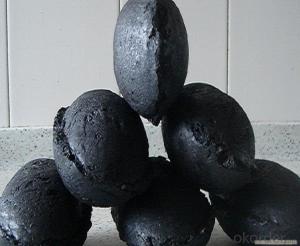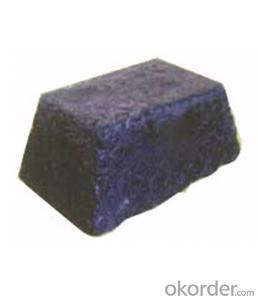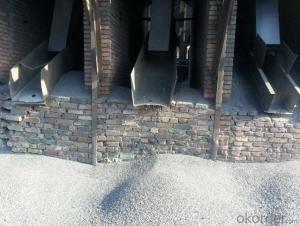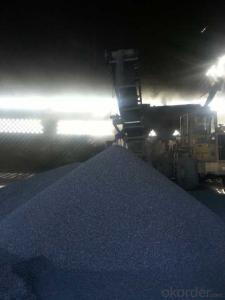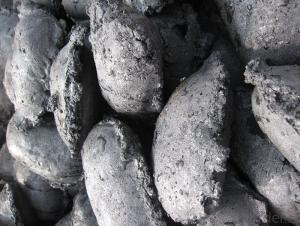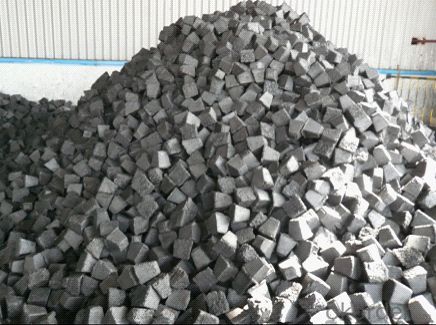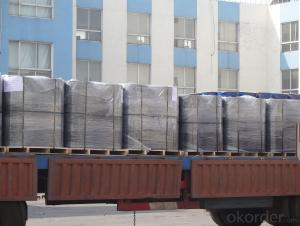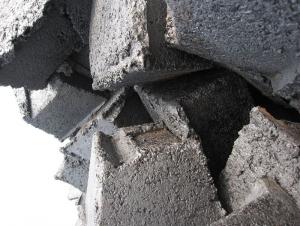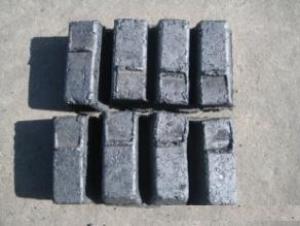Carbon Electrode Paste -Ash9/Low Ash CNBM Product
- Loading Port:
- Tianjin
- Payment Terms:
- TT OR LC
- Min Order Qty:
- 0 m.t.
- Supply Capability:
- 100000 m.t./month
OKorder Service Pledge
OKorder Financial Service
You Might Also Like
Product Description
Carbon Electrode Paste is a self-baking electrode used in submerged arc furnaces for delivering power to the charge mix. Electrode Paste is added to the top of the electrode column in either cylindrical or briquette form. As the paste moves down the electrode column the temperature increase causes the paste to melt and subsequently bake forming a block of electrically conductive carbon. Electrode Paste is essentially a mix of Electrically Calcined Anthracite (ECA) or Calcined Petroleum Coke (CPC) with Coal Tar Pitch.
Packaging & Delivery
Packaging Details: | 1.1MT jumbo bag or as your requirment |
Delivery Detail: | 15 days after receiving advance payment or LC |
Spcifications
1:carbon eletrode paste
2:for ferroalloy,calcium carbide manufacture
3:HS 3801300000,YB/T5212-1996,ISO9001:2008
Graphite/Carbon Electrode Paste
Specification/Item | ||||||
Ash | 4.0%max | 5.0%max | 6.0%max | 7.0% Max | 9.0% Max | 11.0% Max |
VM | 12.0%-15.5% | 12.0%-15.5% | 12.0%-15.5% | 9.5.0%-13.5% | 11.5%-15.5% | 11.5%-15.5% |
Compress Strength | 18.0Mpa Min | 17.0Mpa Min | 15.7Mpa Min | 19.6Mpa Min | 19.6Mpa Min | 19.6Mpa Min |
Specific Resistance | 65μΩm Max | 68μΩm Max | 75μΩm Max | 80μΩm Max | 90μΩm Max | 90μΩm Max |
Bulk Density | 1.38G/CM3 Min | 1.38G/CM3 Min | 1.38G/CM3 Min | 1.38G/CM3 Min | 1.38G/CM3 Min | 1.38G/CM3 Min
|
- Q: Something that seems to be used in the locomotive brake system. I haven't seen it, either. Who knows? It's better for the locomotive system to go back. Thank you!!
- When the skateboard wear to the limit, only in the maintenance of the daily locomotive can be replaced, so that although it is more troublesome, but it is always better than the replacement of contact wire.
- Q: Will long-term use of carbon alloy chopsticks cause cancer?
- The chopsticks are washed with water for a long time, and the water content is especially high. The chopsticks are placed in the non ventilated place for a long time, and the chances of deterioration of the chopsticks are improved." Huang Yahui said, especially the moldy chopsticks, may be contaminated by aflatoxin. It is understood that aflatoxin is the 1 class of carcinogens, is a highly toxic highly toxic substances, human and animal liver tissue will have a damaging effect, can lead to serious liver cancer or even death. Huang Yahui warned that the public should be weekly chopsticks into boiling water after half an hour, placed in the air to air dry before use, it can achieve the disinfection effect, and can effectively and conveniently remove mildew in chopsticks. In addition, it is best to use half a year to replace the new chopsticks, so you don't have to worry too much. "The selection of chopsticks is also very exquisite."." Huang Yahui said, "the ideal chopsticks are bamboo chopsticks and non staining wooden chopsticks.". After the dyed or painted wood, paint and stain will enter the body with food. When in use, especially the stain in heavy metals, benzene and other harmful substances, can cause gastrointestinal inflammation, ulceration, erosion, serious can cause cancer.
- Q: Why is carbon content of stainless steel low?
- This is because the main alloying elements of martensite chromium stainless steel is iron, chromium and carbon, such as Cr is greater than 13%, there is no gamma phase, such as single-phase alloy ferritic alloy, in any heat treatment system does not produce martensite, therefore must join the forming elements of austenite, Fe-Cr two alloy, to expand, C and N are effective elements, C, N elements adding alloy allows higher CR content. Chromium is one of the most important essential elements in martensitic chromium stainless steels, except chromium. In fact, martensitic chromium stainless steel is a kind of iron, chromium and carbon three element alloy C.However, the corrosion resistance of martensitic stainless steel mainly depends on the content of chromium, but the carbon in the steel due to the formation of stable chromium carbide with chromium, but also indirectly affect the corrosion resistance of steel. Therefore, in 13%Cr steel, the lower carbon content, the higher corrosion resistance. In 1Cr13, 2Cr13, 3Cr13 and 4Cr13 four kinds of steel, the corrosion resistance and strength of the order is just the opposite. In addition, carbon has an effect on the mechanical properties of stainless steel matrix.
- Q: What are the uses of carbon nanotubes?
- Due to their unique properties, carbon nanotubes find wide application across various industries. In the realm of electronics and semiconductors, they are particularly valuable. With exceptional electrical conductivity, carbon nanotubes are ideal for creating smaller and more efficient electronic devices. They can be incorporated as conductive additives in polymers, resulting in materials with enhanced electrical and thermal properties. Another crucial domain where carbon nanotubes excel is materials science. Their exceptional mechanical strength and lightweight nature make them ideal for reinforcing and strengthening materials. By incorporating carbon nanotubes into composites, their mechanical properties can be improved, making them more durable. Furthermore, their usage in constructing super-strong fibers finds relevance in industries such as aerospace and construction. Carbon nanotubes have also found valuable applications in the medical field. They can be utilized in drug delivery systems, wherein drugs are encapsulated within the nanotube structure and directly delivered to specific cells or tissues. This method enables more effective and targeted drug delivery, minimizing the side effects associated with traditional drug administration methods. Additionally, carbon nanotubes are being explored as a potential material for biosensors, facilitating the early detection of diseases and pathogens. In the realm of energy storage, carbon nanotubes are being extensively researched as an alternative to conventional lithium-ion batteries. Their potential to store more energy and charge faster could revolutionize the field of energy storage and power generation. Additionally, carbon nanotubes can be employed as catalysts in fuel cells, enhancing their efficiency and cost-effectiveness. In summary, the applications of carbon nanotubes are vast and continue to expand as new discoveries are made. From electronics to materials science, medicine to energy storage, these nanotubes have the potential to revolutionize various industries and enhance the performance of existing technologies.
- Q: Can carbon be recycled?
- Indeed, carbon has the potential to undergo recycling. Carbon recycling pertains to the process of capturing and reutilizing carbon dioxide (CO2) emissions rather than releasing them into the atmosphere. There exist various approaches to carbon recycling, which include: 1. Carbon capture and storage (CCS): This procedure entails the capture of CO2 emissions from power plants or industrial facilities, followed by their storage underground or in deep ocean formations. CCS aids in preventing the release of CO2 into the atmosphere, thereby reducing its impact on climate change. 2. Carbon capture and utilization (CCU): CCU involves capturing CO2 emissions and transforming them into valuable products. For instance, CO2 can be converted into fuels, chemicals, or construction materials through a range of chemical and biological processes. 3. Enhanced oil recovery (EOR): This technique encompasses the injection of captured CO2 into oil reservoirs to enhance the quantity of recoverable oil. In addition to recycling carbon, it also boosts oil production. 4. Biological carbon sequestration: This method employs plants, trees, and other biological organisms to absorb CO2 from the atmosphere through photosynthesis. By promoting reforestation, afforestation, and sustainable land management practices, we can augment carbon sequestration and offset emissions. While carbon recycling technologies are still under development and refinement, they present promising solutions for mitigating greenhouse gas emissions and addressing climate change. By recycling carbon, we can diminish our dependence on fossil fuels, minimize the release of CO2 into the atmosphere, and strive towards a more sustainable and low-carbon future.
- Q: Why is the longer the carbon chain, the better the hydrophobic properties?
- The carbon chain is the water chain, but the lower the polarity (TA)They have to write fifteen characters ah from702853 (station link TA) can theoretically explain it zhoupeng87 (station link TA) should be the basic alkyl is not hydrophilic, it belongs to the hydrophobic group, the increase of carbon chain length of the hydrophobic whyy0113 (station TA) carbon chain is longer, the more polar groups easily entrapped nature shows hydrophobic alkane name small Jia (TA station) the carbon chain length of hydrophobic chain length, of course, hydrophobic. Cher (station TA) the alkyl chain is hydrophobic, so the longer hydrophobic part content more hydrophobic natural good red sandalwood fragrance (TA station).
- Q: How does carbon cycle through the environment?
- The carbon cycle is the process by which carbon moves between the atmosphere, land, oceans, and living organisms in a continuous cycle. It is crucial for maintaining a stable climate and supporting life on Earth. The cycle begins with carbon dioxide (CO2) in the atmosphere, which is absorbed by plants during photosynthesis. Through this process, plants convert CO2 into organic carbon compounds, such as sugars and carbohydrates, which they use for growth and energy. This carbon is then passed along the food chain as animals consume plants or other animals. When plants and animals die or excrete waste, their organic matter decomposes, releasing carbon back into the environment. This decomposition process is carried out by microorganisms, such as bacteria and fungi, which break down the organic matter and release carbon dioxide as a byproduct. Some carbon may be stored in the soil for long periods, depending on factors like temperature and moisture. This stored carbon in the soil can be released back into the atmosphere through processes like microbial respiration or erosion. Another way carbon returns to the atmosphere is through the burning of fossil fuels such as coal, oil, and natural gas. When these fuels are burned for energy, they release carbon dioxide into the atmosphere, contributing to the greenhouse effect and climate change. The oceans also play a crucial role in the carbon cycle. They absorb a significant amount of carbon dioxide from the atmosphere through a process called carbon sequestration. Marine plants, such as phytoplankton, also photosynthesize and store carbon in their tissues. When these organisms die, they sink to the ocean floor, where the carbon can be stored for long periods in the form of sediment or dissolved in the water. Oceanic circulation and biological processes also redistribute carbon throughout the oceans, with surface water exchanging carbon with the atmosphere. Additionally, the oceans act as a carbon sink, as they can store vast amounts of carbon dioxide, helping to regulate its levels in the atmosphere. Overall, the carbon cycle is a complex and interconnected process that involves various natural and human activities. Understanding and managing this cycle is crucial for mitigating climate change and maintaining the health of our environment.
- Q: How does deforestation contribute to carbon emissions?
- Deforestation contributes to carbon emissions by releasing large amounts of stored carbon dioxide (CO2) into the atmosphere. Trees act as carbon sinks, absorbing CO2 from the air during photosynthesis and storing it in their biomass. When forests are cleared or burned, this stored CO2 is released back into the atmosphere, adding to greenhouse gas levels and contributing to climate change.
- Q: What is carbon neutral construction?
- Carbon neutral construction refers to the process of designing, constructing, and maintaining buildings in a way that minimizes their carbon footprint and offsets any remaining emissions. This involves using sustainable materials, implementing energy-efficient systems, and utilizing renewable energy sources to achieve net-zero carbon emissions throughout the building's lifecycle.
- Q: What is the role of carbon in organic chemistry?
- Carbon is a fundamental element in organic chemistry, playing a crucial role in the structure and function of organic compounds. It is unique in its ability to form stable covalent bonds with other carbon atoms and a wide variety of other elements, leading to the vast diversity of organic molecules found in nature. Carbon's ability to bond with itself and other elements allows for the formation of long chains, branched structures, and ring systems, giving rise to the complex structures and shapes characteristic of organic compounds. In organic chemistry, carbon serves as the backbone for many important biomolecules such as carbohydrates, lipids, proteins, and nucleic acids that are essential for life. It is the basis for the structural diversity and complexity found in living organisms. Carbon's ability to form multiple bonds and its tetrahedral geometry also contribute to the versatility of organic compounds, allowing for the presence of various functional groups such as hydroxyl, carbonyl, amino, and carboxyl groups. Furthermore, carbon's ability to undergo chemical reactions, including oxidation, reduction, addition, substitution, and elimination reactions, is vital in organic chemistry. These reactions are fundamental for the synthesis and modification of organic compounds, enabling the creation of new molecules with specific properties and functions. Carbon's role as a central element in organic chemistry also extends to the study of reaction mechanisms, stereochemistry, and the understanding of the behavior and reactivity of organic compounds. Overall, carbon's unique properties and its ability to form stable covalent bonds with other elements make it the foundation of organic chemistry. Its presence allows for the diverse array of organic compounds that exist, and its participation in chemical reactions enables the synthesis and manipulation of these compounds. Without carbon, the field of organic chemistry and the study of life's building blocks would not be possible.
Send your message to us
Carbon Electrode Paste -Ash9/Low Ash CNBM Product
- Loading Port:
- Tianjin
- Payment Terms:
- TT OR LC
- Min Order Qty:
- 0 m.t.
- Supply Capability:
- 100000 m.t./month
OKorder Service Pledge
OKorder Financial Service
Similar products
Hot products
Hot Searches
